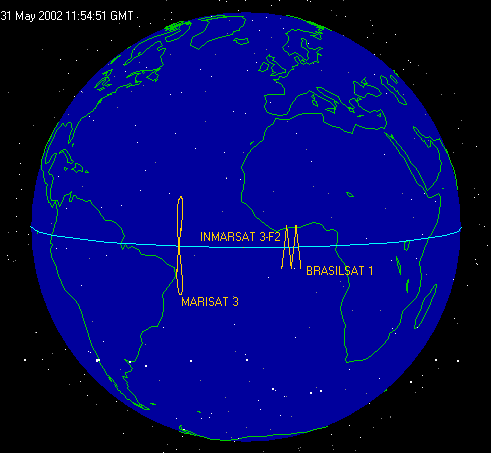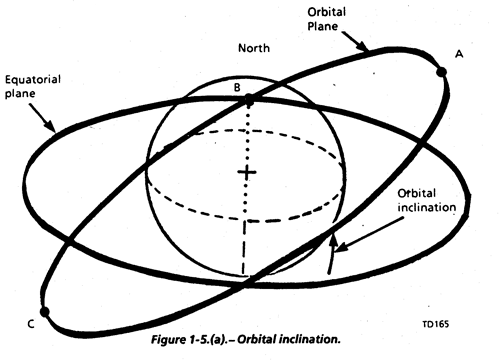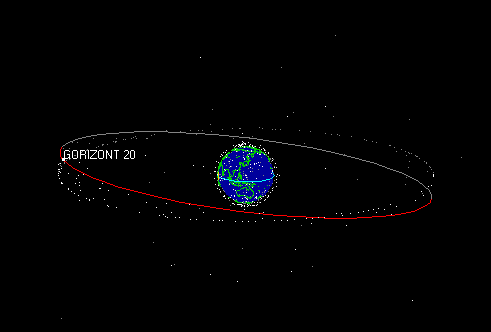


Science and Faith
Science and Faith
Catholic Outlook
Catholic Outlook

Catholic Outlook
Science and Faith
Science and Faith
__________ Recent Additions __________
Catholic Outlook
Catholic Outlook
Dialogue on Looping and
Zig-Zagging Satellites
(Part 2)
How the the apparent motion of geosynchronous
satellites proves that the earth rotates
Gary Hoge
__________ About this Dialogue __________
A continuation of my dialogue with Catholic geocentrist Bob Sungenis. My words are in black, and Bob’s are in blue.
Let’s recap:
I showed the actual ground-tracks for three specific satellites:

I also gave a plausible explanation for the motion of those satellites. I explained that their motion over the ground (figure-eights and zigzags) is simply the result of superimposing their actual motion (which is just your garden-variety circular orbital motion) over a rotating globe. But you say the earth isn’t rotating, in which case any motion relative to the fixed earth must be actual motion caused by actual forces. In other words, if the earth isn’t moving, those satellites really are zooming around in figure-eights and zigzags over the stationary earth. You need to explain how they do that. You need to show how the interaction of real forces causes Marisat 3 to move in a giant figure-eight, how the interaction of those same forces causes Inmarsat 3-F2 to remain stationary, and how the interaction of those same forces causes Brasilsat 1 to move in a slow, steady westward zigzag. In other words, you need to provide a plausible alternative explanation to mine, and so far you have not done so.
Here’s what Gary has miscalculated. Yes, the force of the stars is going to be the same, but because each satellite has a different mass, velocity, height and is sent up with a different inclination, then the results of the force from the stars will be different for each satellite.
Why will the force from the stars be different for each satellite? You need to prove (not just assert) that a constant gravitational force from the far-away, rotating stars will cause satellites to move in radically different paths according to their mass, velocity, height and inclination. And I insist that you do so using the same rules you imposed on me. In the official statement of your geocentrism challenge, you said, among other things, “We don’t want … ‘expert’ testimony.” Well, then, neither do I. I don’t want to see any more quotes from Physics Today, or Dean Turner, or J.P. Vigier, or whoever else you have on your hard-drive. I want to see you explain how the “mass, velocity, height and … inclination” of these three satellites causes them to move in radically different ways in the presence of the same “force from the stars.”
While you’re thinking about how to do that, I’ll go ahead and prove that you can’t by showing that there’s no correlation between any of these factors and the motion of a satellite. Let’s look at them one-by-one:
Velocity and inclination: Sorry, but “differences in orbital velocity and inclination” is my explanation; it can’t be yours, too, unless you’re willing to admit that the earth rotates. But you claim the earth is stationary, and therefore you’ve been forced to assert all along that geosynchronous satellites aren’t orbiting; they’re levitating in “a gravitational and/or electromagnetic band,” remember? Well, if they aren’t orbiting, then obviously they have no orbital velocity and no orbital inclination; they’re just floating up there. So you have to account for the fact that these non-orbiting, levitating objects are being pulled in radically different, though surprisingly regular, patterns by the same distant force.
Altitude: I’m afraid differences in altitude can’t explain why the same force causes these satellites to move in such radically different ways, because the difference between their respective altitudes is so microscopically small compared to their distance from the stars as to be completely negligible. For example, Marisat 3 has a perigee of 35,782 km and Inmarsat 3-F2 has a perigee of 35,769 km. That means the difference between their altitudes is just 13 km. But the stars are billions of kilometers away, and when you’re talking about a scale of billions of kilometers, a difference of only 13 km is nothing. It certainly can’t explain why one of those satellites moves in a figure-eight covering hundreds of miles while the other one doesn’t move at all.
Mass: On its face, this is the least implausible of the factors you mentioned. But if we examine some actual satellites, we’ll see that there’s no correlation between a satellites mass and its motion. The following satellites are grouped according to mass, from lightest to heaviest:
Satellite Mass (kg) Apparent Motion
Amos 1 580 stationary
Eutelsat 1-F4 585 figure-eight
Optus A2 655 zigzag
Optus A3 655 figure-eight
Brasilsat 1 671 zigzag
Brazilsat 2 671 figure-eight
Apstar 1 700 stationary
Gstar 3 759 figure-eight
Cakrawarta 1 802 stationary
Comstar 4 911 figure-eight
Eutelsat 2-F4 915 zigzag
Intelsat 511 1040 figure-eight
Satcom K2 1050 zigzag
AMSC 1 1510 stationary
Obviously, as I said, there’s absolutely no correlation between a satellite’s mass and its motion over the ground.
So, you have your work cut out for you. You need to explain how a constant gravitational force can pull Marisat 3 to the north for hundreds of miles, then suddenly reverse direction and pull it to the south for hundreds of miles. Every day. Like clockwork. You also need to explain why that same force doesn’t move Inmarsat 3-F2 at all. Then you need to explain how that same force pulls Brasilsat 1 slowly to the east while pulling it north, then reversing direction and pulling it south, then reversing direction again and pulling it north, etc.
Previous:
In terms of the stars, he might be right. The stars appear to move around the earth in a perfect circle, and there’s no way to tell just by looking whether that motion is caused by a spinning earth or by rotating stars.
Now, before I add to the explanation of the satellites, I want everyone of you people on this board to pay close attention to the astounding admission Gary just made above. Gary has just admitted, in no uncertain terms, that neither he nor anyone else can prove whether the stars go around the earth or the earth goes around the stars (his “proof “from the GSS satellites, notwithstanding).
Sorry, but my “admission” isn’t quite as “astounding” as you’d like to make it out to be. I simply said you couldn’t tell whether the earth or the stars were moving “just by looking.” There are other ways to tell that the earth rotates, besides geosynchronous satellites, but “just by looking” isn’t one of them.
He has just admitted what I have been saying all along, and the most basic thing I have been arguing - that no one can prove the earth goes around the stars.
No, I’ve just “admitted” that no one can prove the earth goes around the sun (not “the stars”) “just by looking.” I didn’t say no one could prove it at all.
Since that is the case, then someone, like me, who posits that we should listen to the Fathers who taught Geocentrism; listen to the Popes and Saints who censored Copernicanism; that we should take Einstein at his word and accept that the same forces occur in both a Geocentric and Heliocentric universe; that we should listen to Scripture and understand it in its “obvious and literal sense,” has much on his side to present his case. Thanks to Gary’s admission, I couldn’t have argued the point better myself. I am deeply indebted to him for his courage.
Aw, shucks, I’ve been a lot braver since then. It really didn’t take much courage to admit that if I were lying on my back in a field somewhere at night, hands behind my head, a grass stem swaying lazily from my mouth, watching the stars go by, I couldn’t tell, just using my eyes, whether I was moving, or whether they were.
Previous:
Mr. Sungenis simply cannot explain how the same force, operating on nearly identical satellites, at approximately the same altitude causes those satellites to move in radically different ways (or, in the case of Inmarsat 3-F2, not to move at all).
Do you see what Gary tried to slip by you? He said: “...the same force, operating on nearly identical satellites, at approximately the same altitude causes those satellites to move in radically different ways.” The problem is that the satellites are only “nearly identical” and are only “approximately the same altitude.” The fact remains, they are not the same.
Well, of course. If their orbits were exactly the same, they’d follow the same path over the ground. My point all along has been that the wildly different paths these satellites follow relative to the ground is easily explained by slight eccentricities and inclinations in their orbits. But you claim these satellites aren’t orbiting. Therefore, you have to account for their bizarre motion relative to the stationary earth by pointing to actual forces exerted on the satellites by the stars. But so far you haven’t shown how these forces cause the satellites to follow the paths they do.
And any physicist will tell you that to the degree they are different will result in a difference of motion.
Name one reputable physicist who says that. On the contrary, orbital motion has nothing to do with differences in the size, shape, and mass of a satellite. If that were not so, the Space Shuttle could never rendezvous with the International Space Station because those vehicles have very different sizes, shapes, and masses. If your theory were correct, those vehicles should have very different orbital motions. But the truth is, both spacecraft, though they differ significantly in size, shape, and mass, can sail side-by-side in the same orbit indefinitely, thus proving empirically that size, shape, and mass don’t influence orbital motion.
Moreover, Gary forgot to mention that the satellite are sent up with a particular inclination. If so, the satellite must work and move to keep that inclination, otherwise its orbit will decay.
That’s not right. Orbital “inclination” refers to the angle that a satellite’s orbital plane makes with the plane of the equator:

A satellite in the orbit shown above doesn’t have to “work” to maintain its inclination. Gorizont 20, for example, has been out of service since February, 1999, and yet it still “maintains” the inclined orbit shown below:

Obviously, since that satellite has been powered-down for three-and-a-half years, it must not need to “work” to maintain the inclination of its orbit.
And if in that inclination it must exert appropriate centripetal forces in order to keep that inclination,
There are so many errors in that sentence, it’s difficult to know where to start. First of all, satellites don’t exert “centripetal forces” on anything. The earth exerts a centripetal force on the satellite. That’s what makes the satellite orbit. Further, centripetal force is directed in a line between the satellite and the center of the earth, as shown in red below:

You’ll notice that the centripetal force is within the plane of the satellite’s orbit. Therefore, it can’t affect the satellite’s inclination. If you increased the centripetal force, you’d pull the satellite closer to the earth; if you decreased it, the satellite would pull away from the earth. But there’s no way you can move the orbital plane of the satellite closer to the equator by applying a centripetal force. Therefore, it is nonsense to say that a satellite must “exert appropriate centripetal forces in order to keep [its] inclination.”
then we are going to see slightly different movements from it as the centrifugal and centripetal forces balance each other, than from a satellite at a perfectly equatorial or circular placement.
This isn’t right, either. First of all, there’s no such thing as “centrifugal force.” As I’ve said, over and over in the course of this dialogue, it’s a fictitious force. It doesn’t exist. But even if it did exist, if it “balanced” the centripetal force exerted on the satellite by the earth, the satellite would no longer orbit, it would move in a straight line. The reason a satellites flightpath is curved in the first place is because there is no force counterbalancing the centripetal force exerted on the satellite. The satellite is constantly being pulled toward the earth, and only its forward velocity keeps it from being pulled straight down to a fiery end.
Finally, it should be obvious from the above figure that the centripetal force on a satellite in an inclined orbit will be the same as the centripetal force on a satellite in an equatorial orbit. Tilting the orbit would have no effect on a satellites motion in space. In other words, a satellite doesn’t know or care where the equator is. It just orbits in a circle around the earth. It should also be obvious that centripetal force, being entirely radial, can’t cause a satellite to move laterally (e.g., in a zigzag).
(And, by the way, I am only arguing on the basis of a “same force” basis for the sake of argument, since in LaSagean mechanics, there are slightly different forces of gravity on objects depending on their shape and position with respect to the earth.
If this is your answer, you’re going to have to flesh it out. You’re going to have to show me how the shape and position of these three satellites causes one of them to hold still, one of them to move in a figure-eight pattern, and the other to move in a zigzag. I’ll even help you out by giving you the shape and position of each satellite. All you have to do is show me the equations that predict their motion:
Marisat 3 is 2.15 m in diameter and 3.81 m high. Its altitude varies between 35,782 km and 35,789 km each day.
Inmarsat 3-F2 is 2.1 x 1.8 x 1.7 m, with a 16.7 m solar array. Its altitude varies between 35,769 km and 35,804 km each day.
Brazilsat 1 is 2.19 m in diameter and 7.09 m high. Its altitude varies between 35,783 km and 35,788 km each day.
Since you say these satellites aren’t orbiting, I won’t bother to give you the eccentricity and inclination figures. As for their position, all three are at the equator at least twice a day. Now, all you have to do is show me the “LaSagean” equations of motion that predict that a satellite with the parameters of Marisat 3 will do a giant figure-eight, and that a satellite with the parameters of Inmarsat 3-F2 will hold still, and that a satellite with the parameters of Brasilsat 1 will move in a steady eastward zigzag, all under the influence of the same “force from the stars.” Good luck.
Let me make an analogy to help see this a little clearer. It’s not a perfect analogy, but at least it helps visualize the concept. Let’s say there are three men practicing how to descend in mid air from an airplane. To practice, they are placed over a giant air chamber that shoots air upwards at 70 mph. I’m sure you’ve seen them do this. In order to stay at a certain height above the air chamber each man must position himself directly horizontal to the air chamber flow, and curve his arms and legs in such a way so that his body allows just the right amount of air to pass over him and just the right amount to hit him so that the force of the air holds him up against the force of gravity. He must attain this equilibrium or else he will either rise to the roof or hit the ground. In this analogy, the force of air going upward represents the gravitation force from the rotating stars. The men represents the satellites.
Okay, I’m with you so far.
Now, Let’s suppose that each man has a different build, a different weight, a different jump suit, and a different angle or position he wishes to maintain in the air chamber. What, for example, will a short man who weighs 150 pounds with a loose fitting jump suit and who wishes to float with his head slightly up have to do compared to a tall, broad-shouldered man who weighs 250 pounds with a tight fitting jump suit and who wishes to float with his feet slightly elevated? He will have to flex his body a little differently than the other man to make up for the difference in his bodily dimensions. He would, for example, have to cup his body slightly less so that a little less air hits his body than the man who has bigger mass and weight.
Now transfer this analogy to the satellites. Due to the fact that each satellite has a different mass, velocity, inclination, etc, they are going to react differently to the same force of star gravity acting upon them.
There’s one huge problem with this analogy: once these skydivers have achieved the position they want to maintain, they’ll stay in that position unless they move their bodies again. If one of them wanted to move back-and-forth, for example, he’d have to flex his arms or something, and he’d have to keep doing that each time he wanted to change his direction. But you can’t account for the change in direction of a satellite like Brasilsat 1 that way, because that satellite never changes its orbital attitude. That satellite was shut down months ago. Its thrusters are off-line and no one’s controlling it anymore, so obviously its “mass, velocity, inclination, etc.” never change. Yet twice a day it abruptly reverses its direction. You need to explain what causes it to do so, and since its mass, shape, size and orientation never change, you can’t attribute it to those factors.
Gary has already admitted that Marisat 3 was sent up into space with a different inclination than the equatorial satellites. Thus, that means that it must have within its centripetal motion forces exerting against the tide of gravity from the stars. If it exerts different forces, than this will show up in some kind of movement, no matter how slight.
With all due respect, you really need to brush up on your orbital mechanics. First, orbital inclination, as I showed above, has nothing to do with “centripetal motion” (which I assume means “motion in the direction of the center”). Second, satellites don’t exert forces on things. Third, because centripetal force is entirely a radial force, it can’t cause motion in a lateral direction. Fourth, you say these satellites aren’t orbiting, so I don’t see how you can appeal to differences in orbital inclination to explain the motion of non-orbiting objects.
This explains why the dancing satellites (as Gary pointed out) all have different motions. Some are tear dropped; some are figure-eights; some are zig-zag. Why? Since all of them have been sent up with different inclinations and have different weight and shapes, they will all produce different movements. That is to be expected.
Well, if you really “expected” that satellites having these parameters would move in the way they do, why don’t you show us the force equations that led you to expect this sort of motion from these satellites. Why don’t you explain to us why your physics principles led you to anticipate that the different weights and shapes of satellites would cause them to move in tear-dropped, figure-eight, or zigzag shapes. For instance, according to your physics equations, which shapes and masses will result in a tear-drop motion? Which shapes and masses will result in a figure-eight? Which shapes and masses will result in a zigzag?
This brings home another point. As I mentioned before, in Gary’s universe, the Coriolis and centrifugal forces are, as Einstein said himself, “fictitious forces,” or as Gron and Eriksen said “a sort of trick.” Well, the same thing is true for Gary’s explanation of the movement of the these zig-zagging satellites - their movements are fictitious, since they only “appear” to be moving.
Oh, they’re moving. They’re just not really doing figure-eights and zigzags. They’re really moving in circles, just like almost every other satellite. But because the earth is moving, too, they appear (to us on the ground) to be moving in figure-eights and zigzags. But in your world that’s not an apparent motion; it’s an actual motion. And you haven’t yet offered a plausible explanation of how a satellite can move like that.
Unfortunately for Gary, this is how he explains the motions of the stars we see in the sky - they only appear to be moving. Now, he’s already admitted in this post that: “In terms of the stars, he [Sungenis] might be right. The stars appear to move around the earth in a perfect circle, and there’s no way to tell just by looking whether that motion is caused by a spinning earth or by rotating stars.” So he’s already conceded the point that apparent motion in his universe may in fact be real motion in the real universe. Well, I’m just applying this same principle to his “apparently” moving satellites.
In your world, though, the figure-eights and zigzags these satellites make every day are actual motion. But you still haven’t explained how they move like that. It’s obvious that the loops, figure-eights and zigzags of the geosynchronous satellites are adequately explained as being merely the combination of circular orbits and a rotating earth. But I don’t think there’s any physics known to man that can account for a satellite (1) levitating above the earth in defiance of the earth’s gravity, and (2) moving in a perfect figure-eight or zigzag. If you think your physics can account for these facts, by all means Let’s see the proof.
Since each satellite, because it is sent up with a different inclination, must react differently to the gravitational force of the stars, thus we would expect to see REAL reactions from them, not apparent reactions. The only reason Gary is forced to call them “apparent” reactions is that that is the only way to explain them if you’ve already assumed that the earth is rotating.
No, it’s the only way to explain them, period. If you disagree, then show me a plausible alternative. If you think the “gravitational force from the stars” can make Marisat 3 move in a giant figure-eight every day, while simultaneously holding Inmarsat 3-F2 motionless and pulling Brazilsat 1 in a slow eastward zigzag, then you need to explain how that works; you can’t just assert that it does. You need to explain how the same force simultaneously causes each of those different motions. I don’t care how you do that, but you need to do it. Give me a narrative description, show me the equations, draw me a picture, do something. If you can’t, then my proof stands.
Part 1, Part 2, Part 3, Part 4, Part 5
Copyright © 2024 Catholicoutlook.me
MENU